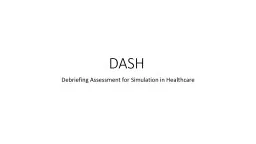

in Healthcare Introduction Simulations have become an integral part of the curriculum for health care professionals The advantages of practicing critical infrequent events and also practicing procedures in a safe environment are invaluable ID: 682891
Download Presentation The PPT/PDF document "DASH Debriefing Assessment for Simulati..." is the property of its rightful owner. Permission is granted to download and print the materials on this web site for personal, non-commercial use only, and to display it on your personal computer provided you do not modify the materials and that you retain all copyright notices contained in the materials. By downloading content from our website, you accept the terms of this agreement.
Slide1
DASH
Debriefing Assessment for Simulation
in HealthcareSlide2
Introduction
Simulations have become an integral part of the curriculum for health care professionals
The advantages of practicing critical infrequent events and also practicing procedures in a safe environment are invaluable
Simulations are being used to provide formative and summative competenciesSlide3
Debriefing
Facilitated conversations
Participants analyze:
Their actions
Thought processes
Emotional statesSlide4
Debriefing
Adult Learning principles
Reflection
Feedback (clear, honest)
Psychologically safe environment
Future experimentationSlide5
WHY DASH
Only debriefing tool that assesses debriefing in a wide variety of health care contexts
Uses BARS
(behaviorally
anchored rating
scale)Slide6
DASH ELEMENTS
Establishes an engaging environment
Clarifies course objectives
Environment
Confidentiality
Roles
Establish “fiction contract”
Attends to logistic details
Conveys a commitment to respecting learners and understanding their perspectiveSlide7
DASH ELEMENTS
Maintains an engaging learning environment
Clarifies debriefing objectives, roles, and expectations
Helps participants engage in a limited-realism context
Structures the debriefing in an organized way
Encourages trainees to express their reactions and, if needed, orients them to what happened in the simulation, near the beginning
Guides analysis of the trainees’ performance during the middle of the session
Collaborates with participants to summarize learning from the session near the end
Clarifies debriefing objectives, roles, and expectations
Helps participants engage in a limited-realism contextSlide8
DASH ELEMENTS
Provokes engaging discussions
Uses concrete examples and outcomes as the basis for inquiry and discussion
Reveals own reasoning and judgments
Facilitates discussion through verbal and nonverbal techniques
Uses video, replay, and review devices (if available)
Recognizes and manages the upset participant
Identifies and explores performance gaps
Provides feedback on performance
Explores the source of the performance gapSlide9
DASH ELEMENTS
Helps trainees achieve or sustain good future performance
Helps close the performance gap through discussion and teaching
Demonstrates firm grasp of the subject
Meets the important objectives of the sessionSlide10
DASH RATING SCALE
Rating
7
6
5
4
3
2
1
Descriptor
Extremely effective/outstanding
Consistently
effective/very good
Mostly
effective/good
Somewhat
effective/average
Mostly
ineffective/poor
Consistently
ineffective/very poor
Extremely
ineffective/abysmalSlide11
CONCLUSIONS
Evidence suggests
that simulation
A
ccompanied
by
high-quality debriefings
Facilitates
transfer of new knowledge, skills
, and
attitudes
Primarily through enactment
of the reflection stage of experiential learning
Opportunity
for the experimentation aspect
DASH can provide valuable
feedback
to facilitate
the educational
processes
within
debriefing